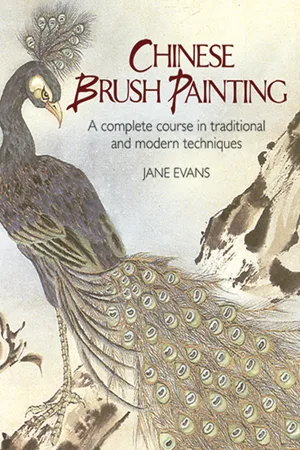
This is a test
- 144 pages
- English
- ePUB (mobile friendly)
- Available on iOS & Android
eBook - ePub
Book details
Book preview
Table of contents
Citations
About This Book
Comprehensive "how-to" manual takes all levels of students through the creative process, providing detailed instructions for painting such simple subjects as bamboo and plum blossoms as well as more ambitious motifs: birds, fish, and landscapes. Some sections describe how to adapt Chinese brush painting to Western subjects. 150 illustrations, including 82 in full color.
Frequently asked questions
At the moment all of our mobile-responsive ePub books are available to download via the app. Most of our PDFs are also available to download and we're working on making the final remaining ones downloadable now. Learn more here.
Both plans give you full access to the library and all of Perlego’s features. The only differences are the price and subscription period: With the annual plan you’ll save around 30% compared to 12 months on the monthly plan.
We are an online textbook subscription service, where you can get access to an entire online library for less than the price of a single book per month. With over 1 million books across 1000+ topics, we’ve got you covered! Learn more here.
Look out for the read-aloud symbol on your next book to see if you can listen to it. The read-aloud tool reads text aloud for you, highlighting the text as it is being read. You can pause it, speed it up and slow it down. Learn more here.
Yes, you can access Chinese Brush Painting by Jane Evans in PDF and/or ePUB format, as well as other popular books in Art & Art Techniques. We have over one million books available in our catalogue for you to explore.
Information
Topic
ArtSubtopic
Art TechniquesPAINTING BIRDS
It is perhaps in gongbi paintings of birds that the drawbacks of the Chinese habit of copying show up most clearly. Although they are often decorative, birds in Chinese paintings are frequently static and occasionally anatomically unrealistic. In paintings of birds artists have shown a tendency to concentrate on using the correct brush stroke at the expense of conveying the nature of the subject. There are, of course, many very beautiful gongbi bird paintings and some which would grace any bird watchers’ manual for accuracy. However, I personally feel they sometimes lack that essential element of movement that is so extraordinarily well captured by successful xieyi bird painting. You can avoid some of the pitfalls of overstylization by remembering the moral of the story about the painters of the ducks (see page 19). Look at birds; see how they fly, land, perch and eat.
Small birds: gongbi style
As you will see from figure 78, gongbi-method birds should first be drawn with a fine-pointed brush. Start by drawing the eye and the beak in black ink. With grey ink and a feathered brush, lightly outline the head. Next put in the black wing feathers with a bamboo leaf stroke. Again with grey and a feathered brush, add the back and the breast. Lastly, put in the tail and the legs. Obviously the shape of the bird should be varied according to the species, as should the colouring, which, as you will by now expect in a gongbi painting, will be done by blending. Remember to blend from light to dark. Once you have filled in the basic colours, put in the markings such as the little cross bars on the wings. Add a touch of white to the eye to bring it alive. If you want to give your bird a speckled breast, fill a small brush with the predominant light colour you want and tip it in a darker tone, then use it with a dabbing motion, overlapping your strokes. Figure 79 illustrates a gongbi small bird in colour.
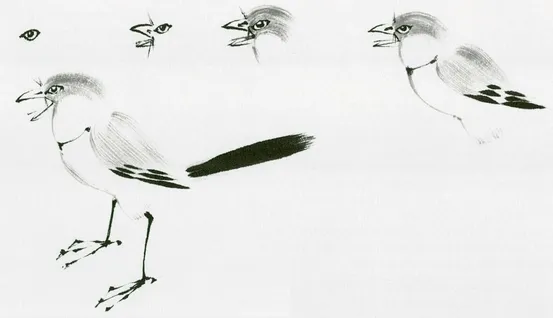
Figure 78 Gongbi-method bird showing how the finished creature is built up
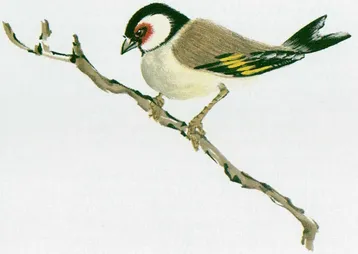
Figure 79 Gongbi bird in colour
Large birds: gongbi style
In figures 80 and 81 large birds are treated in the detailed manner – the method is essentially the same as for small birds. You should begin by outlining the eye and the beak, and then draw in the head, wings, back, breast, tail, legs and feet. The peacock on page 16 was also painted in this way.
Some large birds are painted in meticulous detail with many of their feathers put in individually. Figure 82 shows a selection of different feathers. In each case, start by marking in the spine in light ink. Using a small split brush, work outwards from the spine with a feather stroke. Then reverse the stroke and feather inwards from the outer edge. Next, add a wash of the predominant colour of the bird. Emphasize the spine with black and highlight it with white if this is appropriate to the colouring of your bird. You may also need to highlight the edge of the feather. This basic method for painting feathers can be adapted for most shapes, colour schemes and sizes.
Figure 80 Owl. This is painted by the gongbi method and shows the use of the speckled technique. The moon is painted in white gouache on the back of the painting so that when the wash is added to the front an effect of clouds scudding across the moon is achieved. The sky effect is created by applying a variegated wash
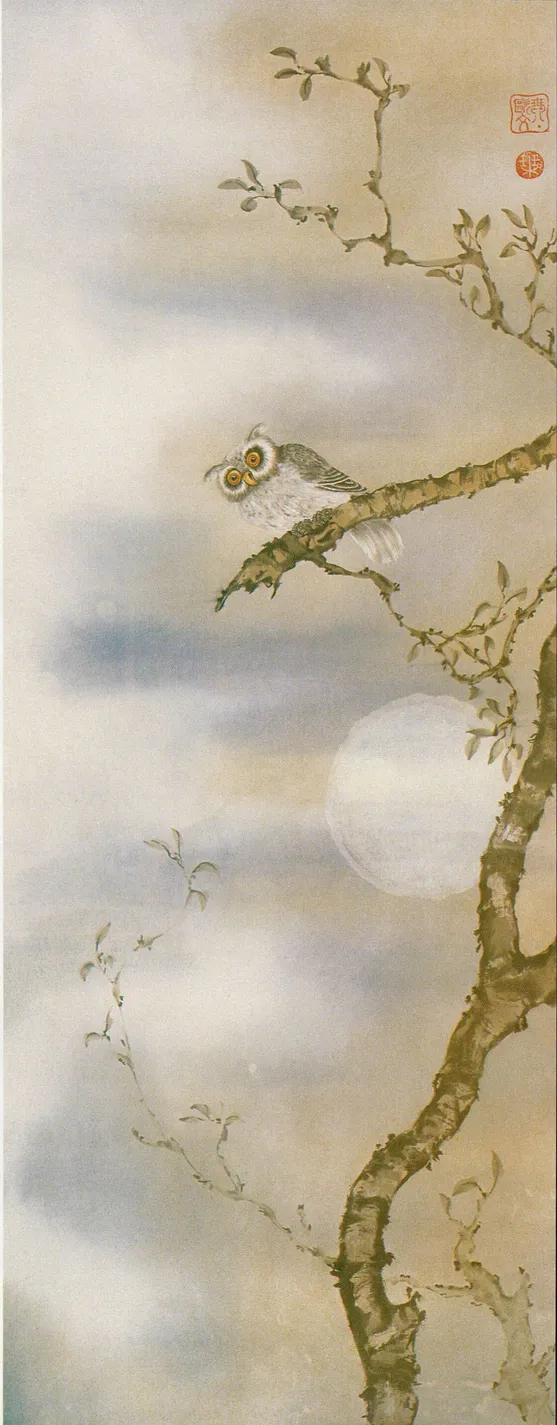
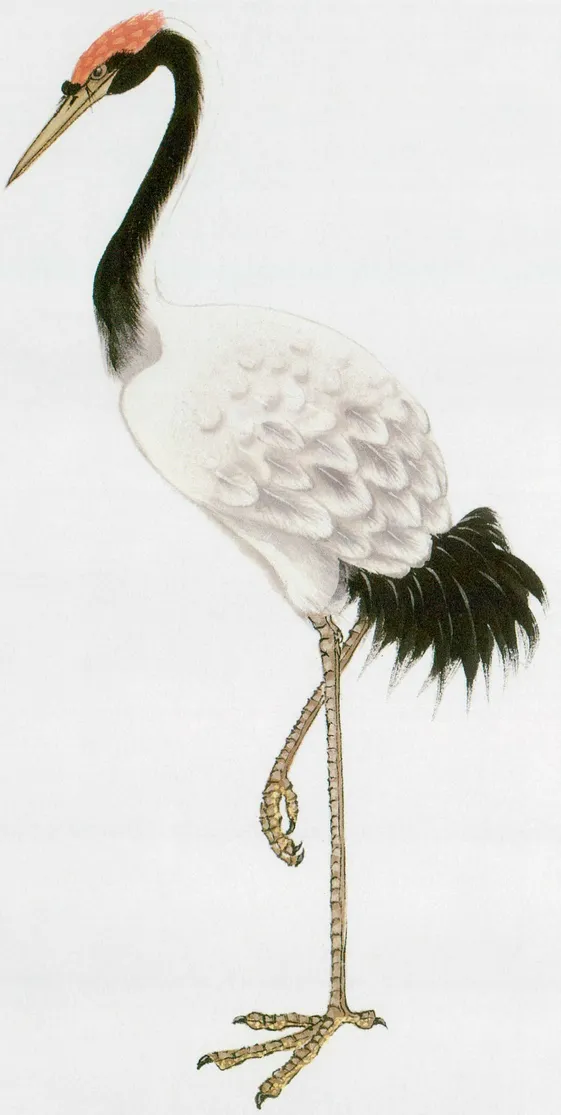
Figure 81 A crane is a symbol of longevity which often occurs in paintings alongside pine trees
Normally the breasts of birds are painted with blended colours and do not have the feathers marked individually, although ducks are sometimes an exception to this rule. The crane’s tail (figure 81) is done with sweeping, bamboo leaf strokes. When painting a peacock, as illustrated on page 16, it is advisable to establish the overall shape of the tail by marking the tail feathers lightly in grey. If you cannot obtain any Chinese or Japanese gold paint for these feathers you can use gold plaka. However, you will need to add this after the picture has been mounted as it tends to wash off otherwise. Figure 83 gives some examples of the legs and feet of birds also done by this detailed method.
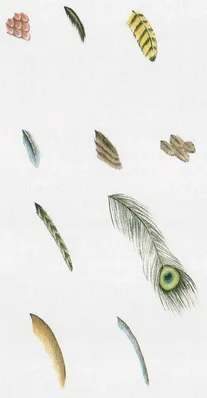
Figure 82 A selection of feathers. A feathered brush should be used for the smaller feathers; for the larger ones, it is more effective to apply very fine, tapered, individual strokes with the tip of a small brush

Figure 83 Birds’ legs and feet. To create a spotted effect, the spots are put in with gouache white or gouache white mixed with yellow before the overall colour of the leg or foot is added. Highlighting on the front sections of the legs and on the tops of the feet should be blended in on top of the colour
Small birds: xieyi style
Watching birds is essential if you are going to paint freestyle ones which successfully convey movement and life. Small freestyle birds are begun by painting either the belly or the back, depending on the angle of the bird. For figure 84, take a soft sheep-, goat-or rabbit-hair brush and saturate it in the light breast colour. Tip the brush with darker colour, then place it so that the darker tone will come at the chin and press down firmly onto the paper, moving the brush to make the shape of the bird’s chest. Try to do this in one movement. Lift the brush and split it, then feather the edges of the breast. Fill your brush with a darker colour and paint the shoulder area of the back with a sideways stroke. When you have done this, change to a firmer brush, preferably a horse-hair one if you have it, and put in the eye and the beak with bold strokes. For the top of the head, fill your brush with ink or colour and place it so that the tip forms the front of the face above the beak. Lay the brush down firmly, turning it slightly so that the heel meets the shoulder. Make a second stroke for the top of the head in the same manner, but this time include a small bump above the eye by moving the brush slightly sideways while you are laying it down. You should never use more than two strokes for the top of the head. Do the wing next with a bold side stroke, augmented by one or two pushed vertical strokes, then add the tail. Paint the markings round the eye and those on the cheek, chest, head and wings. Colour the beak and put in the tongue if the mouth is open. Highlight the eye with a dab of white, and also fill in the cheek with white if appropriate. Lastly, add the feet.
Figure 84 Small xieyi bird showing how the creature is built up beginning with the breast. It is vital to do a xieyi bird ‘in one breath’ so that the colours blend. It is equally important to have strong black ink and good colour tones if you want your bird to look lively
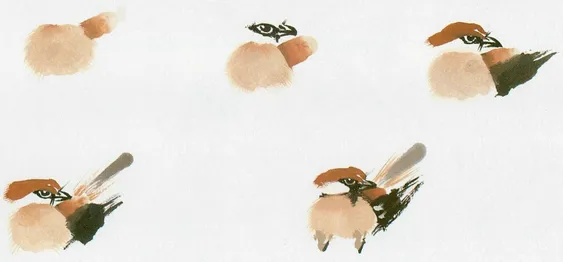
The bird in figure 85 is done by exactly the same method except that this time the back is painted first with the soft brush. The feathering technique should be used not to puff up the chest but to pull the stroke backwards, providing the base of the tail. The black tail feather...
Table of contents
- DOVER BOOKS ON ART INSTRUCTION
- Title Page
- Copyright Page
- Note
- Errata
- Table of Contents
- Acknowledgements
- Note on the spelling of Chinese words and names
- Preface
- THE APPEAL OF CHINESE BRUSH PAINTING
- PAINTING IN CHINESE CULTURE
- EQUIPMENT
- MAKING A START
- PAINTING PLUM OR JADE BLOSSOM
- PAINTING BAMBOO
- PAINTING ORCHIDS
- PAINTING CHRYSANTHEMUMS
- PAINTING ROCKS
- PAINTING PINE
- PAINTING GRASSES
- PAINTING PEONY
- PAINTING LOTUS
- PAINTING INSECTS
- PAINTING FISH AND OTHER AQUATIC CREATURES
- PAINTING BIRDS
- PAINTING MAMMALS
- PAINTING PEOPLE
- PAINTING LANDSCAPES
- APPLYING WASHES
- MORE ADVENTUROUS TECHNIQUES
- MOUNTING AND PRESENTATION
- IN CONCLUSION
- WHERE TO SHOP
- BIBLIOGRAPHY